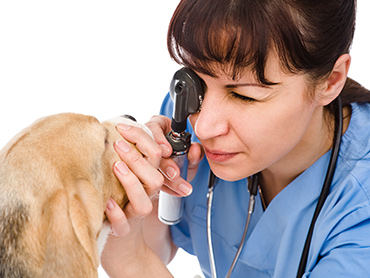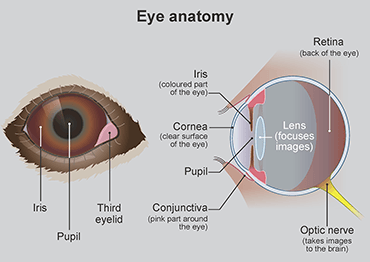Eye problems in dogs - an overview
General information
There are many different conditions that can affect your dog’s eyes, including: injuries, infections, pressure changes, eyelash/eyelid problems, and even an illness in another part of the body e.g. diabetes.
Problems with the eyes can present themselves in many different ways. To prevent loss of vision, they should always be taken seriously and dealt with quickly. This article gives an overview of the most common eye symptoms and conditions we see in dogs.

When to contact your vet
Contact your vet as soon as you notice a problem with your dog’s eyes. Leaving your dog without treatment could lead to much more serious problems developing and even loss of vision/blindness.
Consider taking out dog insurance as soon as you bring your dog home, before any signs of illness start. This will give you peace of mind that you have some financial support if they ever become unwell.
Symptoms
If your dog has a problem with either of his/her eyes, you may notice the following symptoms:
- Weeping/discharge
- Redness or swelling
- Cloudiness
- Pain/blinking/keeping one or both eye(s) closed
- Third eyelid showing
- A lump in or around the eye
- Loss of vision
- Blood in the eye
- A bulging eye
- A change in the size or shape of the pupil
Common eye conditions
- Eye infections/conjunctivitis - eye infections can be caused by bacteria or viruses. If your dog suffers from frequent eye infections, it’s possible that there could an underlying cause such as XXXdry eye.
- Eye ulcers - a wound on the surface of the eye (the cornea). Ulcers need treatment to help them heal and can lead to loss of an eye if neglected.
- Dry eye – a condition that stops the eye producing enough tears.
- Cherry eye – cherry eye is when the gland inside the third eyelid pops out (it looks like a small, red cherry in the corner of the eye).
- Eyelid problems – inward or outward turning eyelids (entropion/ectropion) can cause inflammation, pain and infections.
- Eyelash problems – it’s common for dogs to have eyelashes that grow in the wrong direction, from the wrong place or even a whole extra row of them. Any eyelash that rubs on the surface of the eye will cause irritation.
- Lens luxation – when the lens (see image below), comes out of position.
- Cataracts – when the lens inside the eye becomes cloudy it’s called a cataract. Cataracts reduce vision and over time, often lead to blindness.
- Glaucoma – is increased pressure inside the eye. Glaucoma is a painful condition that can quickly lead to blindness if left untreated.
- Uveitis – inflammation of the coloured part of the eye (the iris) and the structures around it (see image below).
- Pannus – ongoing inflammation, caused by a fault in the immune system, which causes little lumps to form on the surface of the eye.
- Blindness – many different eye problems can cause blindness. Fortunately, dogs seem to be better at adapting to blindness than humans, perhaps because they compensate with their excellent sense of smell and hearing.
- Masses and tumours – behind, in and around the eye. It’s important to get any new lumps checked by your vet.
Eye anatomy
- Eyelids - dogs have three eyelids; an upper lid, lower lid and a third eyelid in the inside corner of the eye, beneath the outer lids.
- Conjunctiva - the soft, pink tissues inside the eyelids and around the eyeball.
- Cornea – the clear, front surface of the eyeball.
- Iris - the circular coloured part of the eye.
- Pupil - the hole in the iris that lets light into the eye.
- Lens - the lens is a small, transparent disc inside the eyeball. It focusses images on the back of the eye.
- Retina - the back of the eye where a layer of light-sensitive cells receive images.
- Optic nerve - the nerve that transmits image signals to the brain, enabling sight.

Published: February 2020
Did you find this page useful?
Tell us more
Please note, our vets and nurses are unable to respond to questions via this form. If you are concerned about your pet’s health, please contact your vet directly.
Thank you for your feedback
Want to hear more about PDSA and get pet care tips from our vet experts?
Sign up to our e-newsletter
Written by vets and vet nurses. This advice is for UK pets only. Illustrations by Samantha Elmhurst.

